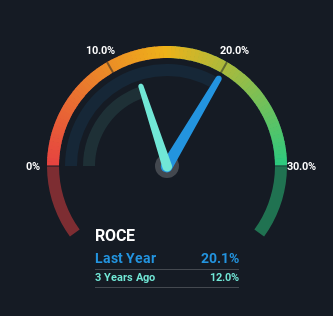Vulcan Steel (ASX:VSL) Is Reinvesting At Lower Rates Of Return
To find a multi-bagger stock, what are the underlying trends we should look for in a business? Firstly, we'll want to see a proven return on capital employed (ROCE) that is increasing, and secondly, an expanding base of capital employed. Ultimately, this demonstrates that it's a business that is reinvesting profits at increasing rates of return. Looking at Vulcan Steel (ASX:VSL), it does have a high ROCE right now, but lets see how returns are trending.
What Is Return On Capital Employed (ROCE)?
If you haven't worked with ROCE before, it measures the 'return' (pre-tax profit) a company generates from capital employed in its business. To calculate this metric for Vulcan Steel, this is the formula:
Return on Capital Employed = Earnings Before Interest and Tax (EBIT) ÷ (Total Assets - Current Liabilities)
0.20 = NZ$163m ÷ (NZ$1.0b - NZ$191m) (Based on the trailing twelve months to June 2023).
Thus, Vulcan Steel has an ROCE of 20%. That's a fantastic return and not only that, it outpaces the average of 9.1% earned by companies in a similar industry.
Check out our latest analysis for Vulcan Steel
In the above chart we have measured Vulcan Steel's prior ROCE against its prior performance, but the future is arguably more important. If you'd like to see what analysts are forecasting going forward, you should check out our free report for Vulcan Steel.
What Does the ROCE Trend For Vulcan Steel Tell Us?
When we looked at the ROCE trend at Vulcan Steel, we didn't gain much confidence. While it's comforting that the ROCE is high, five years ago it was 29%. However, given capital employed and revenue have both increased it appears that the business is currently pursuing growth, at the consequence of short term returns. If these investments prove successful, this can bode very well for long term stock performance.
On a related note, Vulcan Steel has decreased its current liabilities to 19% of total assets. That could partly explain why the ROCE has dropped. Effectively this means their suppliers or short-term creditors are funding less of the business, which reduces some elements of risk. Since the business is basically funding more of its operations with it's own money, you could argue this has made the business less efficient at generating ROCE.
In Conclusion...
Even though returns on capital have fallen in the short term, we find it promising that revenue and capital employed have both increased for Vulcan Steel. These trends are starting to be recognized by investors since the stock has delivered a 6.5% gain to shareholders who've held over the last year. Therefore we'd recommend looking further into this stock to confirm if it has the makings of a good investment.
On a final note, we've found 3 warning signs for Vulcan Steel that we think you should be aware of.
High returns are a key ingredient to strong performance, so check out our free list ofstocks earning high returns on equity with solid balance sheets.
Have feedback on this article? Concerned about the content? Get in touch with us directly. Alternatively, email editorial-team (at) simplywallst.com.
This article by Simply Wall St is general in nature. We provide commentary based on historical data and analyst forecasts only using an unbiased methodology and our articles are not intended to be financial advice. It does not constitute a recommendation to buy or sell any stock, and does not take account of your objectives, or your financial situation. We aim to bring you long-term focused analysis driven by fundamental data. Note that our analysis may not factor in the latest price-sensitive company announcements or qualitative material. Simply Wall St has no position in any stocks mentioned.

